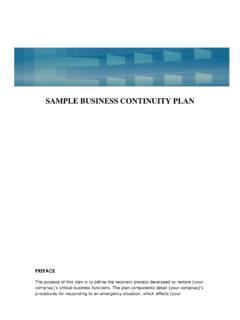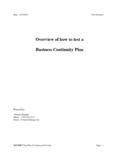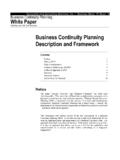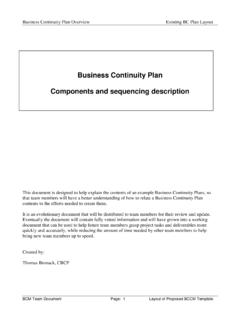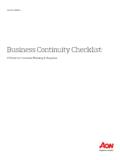Transcription of Operational Risk Management and Business …
1 T e c h n i c a l N o t e s a n d M a n u a l s Operational Risk Management and Business continuity Planning for Modern State Treasuries Ian Storkey Fiscal Affairs Department TNM/11/05. International Monetary Fund Fiscal Affairs Department 700 19th Street NW. Washington, DC 20431. USA. Tel: 1-202-623-8554. I nt e r nati o na l M o n e ta r y F und Fax: 1-202-623-6073. INTERNATIONAL MONETARY FUND. Fiscal Affairs Department Operational Risk Management and Business continuity Planning for Modern State Treasuries Prepared by Ian Storkey Authorized for distribution by Sanjeev Gupta November 2011. DISCLAIMER: This Technical Guidance Note should not be reported as representing the views of the IMF. The views expressed in this Note are those of the authors and do not necessarily represent those of the IMF or IMF policy. JEL Classification Numbers: H12, H60, H63, H83.
2 Keywords: Business continuity , disaster recovery, Business continuity and disaster recovery plan, Operational risk, Operational risk Management , treasury operations Author's E-Mail Address: T E C H N I C A L N o te s an d M A N U A L s Operational Risk Management and Business continuity Planning for Modern State Treasuries Prepared by Ian Storkey This technical note and manual (TNM)1 addresses the following main issues: What is Operational risk Management and how this should be applied to treasury operations. What is Business continuity and disaster recovery planning and why it is important for treasury operations. How to develop and implement a Business continuity and disaster recovery plan using a six practical-step process and how to have it imbedded into the day-to-day operations of the treasury. What is needed to activate and what are the key procedures when activating the disaster recovery plan.
3 Introduction Management of financial risk is very important for the treasury operations of any ministry of finance. Ministry of finance bears responsibility for the Management of very substantial government assets and liabilities, and for the Management of many large value transactions, probably much more than any other government ministry or agency. The large sums involved mean that any risk exposure can have damaging financial consequences on the budget out- turn and the overall government balance sheet. But there is potentially also severe reputa- tional and political damage associated with Operational errors or failures, reflecting on the competence of the ministry of finance covering treasury operations. Ministry of finance is potentially exposed to and will have a particular appetite for expo- sure to a wide range of risks .
4 Figure 1 illustrates the perceived risks : financial risks : traditionally managed by a risk Management unit located in the ministry of finance that includes market, liquidity, and credit risks 1 Note: Ian Storkey is an international consultant specializing in government debt and cash Management and is on the Fiscal Affairs Department roster of experts. This note has benefitted from comments from Mario Pessoa (FAD), Is- rael Fainboim (FAD), Mike Williams (consultant) and the Mexican Federal Treasury. The author would also like to ac- knowledge the information obtained or provided by the governments in Australia, Chile, Turkey and United Kingdom. Technical Notes and Manuals 11/05 | 2011 1. Figure 1: Perceived Treasury risks Treasury risks Operational risks Financial risks risks Addressed by BCP. Business risks Business risks : such as new legislation, change of government, macro-economic perfor- mance and any other factors affecting the ministry of finance's environment these are often managed as part of the budget planning process Operational risks : a range of threats from loss of key personnel, settlement failure, and compliance failure, to theft, systems failure and building damage Operational risk Management aims to ensure the integrity and quality of the operations of ministry of finance and treasury using a variety of tools including audit, recruitment policies, system controls, and Business continuity planning.
5 Awareness of Operational risk is low in many countries, and very few ministries of finance have a Business continuity and disaster recovery plan (BCP/DRP). Often it is perceived as something applicable only to the private sector and attracts little attention by senior manage- ment. This is because it is not seen as important or a priority, there are inadequate resources allocated to establish and maintain an Operational risk Management (ORM) framework including BCP/DRP, responsibility is delegated to information technology, and it becomes a one-off project rather than an integral part of the day-to-day treasury operations. Management neglect is often at fault with the belief that it won't happen to me . The problem of course is that ORM covers a wide umbrella, often seen as covering every- thing except for market, liquidity, and credit risks .
6 Unlike market or credit risk, Operational risk is mainly endogenous to the ministry of finance. Apart from external events such as natural catastrophes, it is linked to the Business environment, nature and complexity of trea- sury operations, the processes and systems in place, and the quality of the Management and of the information flows. There is normally no regulatory pressure to put in place adequate 2 Technical Notes and Manuals 11/05 | 2011. measures to monitor and control Operational risks and maintain a BCP/DRP as is the case with central banks. In this paper, references to the ministry of finance (MoF) should be taken to include treasury operations (managed by the treasurer), notwithstanding that some countries have a separate treasury department or agency. A debt Management unit (DMU) may also be part of ministry of finance or separately constituted ( as a debt Management office, DMO).
7 The DMU or DMO may perform some of the treasury operations such as cash Management , although these will often be shared with or in coordination with ministry of finance. Introduction to Operational Risk Management Definition Under Basel II developed by the Bank for International Settlements (BIS) 2, Operational risk is de- fined as the risk of loss resulting from inadequate or failed internal processes, people and systems or from external events. The definition explicitly includes legal risk, but excludes strategic and reputation risk. While this definition and sound practices established by the Basel Committee on Banking Supervision and COSO, and usefully elaborated by entities such as TransConstellation, have been primarily designed for the banking and financial sector, the governing principles can appropriately be applied to treasury What is necessary is an ORM framework that is appropriate to the range and nature of treasury operations and the operating environment.
8 For treasury, the categories of risks , such as market risk (exchange rate and interest rate risk), liquidity risk, and credit risk are relatively well known; however Operational risk is not. Govern- ment treasurers are now beginning to understand Operational risk Management and the impor- tance to their treasury. A summary of Operational risks faced by the treasury is set out in Box 1. Business continuity planning should be an integral part of the ORM framework for treasury. What is ORM? The treasurer should be aware of the major aspects of Operational risks as a distinct risk category that should be managed, and should approve and periodically review the Operational risk manage- ment framework applicable to treasury. The framework should provide a definition of Operational risk and lay down the principles of how Operational risks are to be identified, assessed, monitored, and controlled or mitigated.
9 A risk committee may be in place to oversee this. process. 2 Basel II International Convergence of Capital Measurement and Capital Standards: A Revised Framework , published by the Bank for International Settlements in June 2004. 3 The Basel Committee on Banking Supervision has members from 28 countries that provide a BIS forum for regular cooperation on banking supervisory matters. The Committee of Sponsoring Organizations of the Treadway Commission (COSO) is a joint initiative of five private sector organizations and is dedicated to the development of frameworks and guidance on enterprise risk Management , internal control and fraud deterrence. TransConstellation is a Belgian not-for-profit entity in the field of financial-transaction processing with members that include Banksys, Euroclear, Fin-Force, SWIFT and The Bank of New York (Brussels office).
10 Technical Notes and Manuals 11/05 | 2011 3. Box 1: Typical Treasury Operational risks Infrastructure and technology failures covering computer systems, power, telecom- munications, data and physical records Incidents where access to premises is denied, either through inaccessibility or build- ing damage Dependencies on third party key service providers such as the central and/or com- mercial banks, telecom and internet providers, and other outsourced operations, or resource failures from such incidents as a pandemic. Human errors or failures through lack of resources, skills, training, policies, proce- dures, delegations, code of conduct, and poor Management Failure to meet statutory, legal or contractual, human resources and other obliga- tions including Management objectives and reporting obligations Natural and regional disasters covering incidents such as earthquake, tsunami, severe flooding, hurricane/typhoon, volcanic eruption, severe fires, landslides and civil disturbance or terrorism Senior Management in treasury should have responsibility for implementing the ORM.
